The agricultural films market is projected to grow from USD 12.52 billion in 2025 to USD 21.02 billion by 2034, registering a CAGR of 5.94%. This report provides an in-depth analysis of market trends, material types, and applications, covering LLDPE, EVA, mulch films, greenhouse films, and bale wrapping solutions. Regional insights include North America, Europe, Asia-Pacific, Latin America, and the Middle East & Africa, highlighting Asia-Pacific’s leading share in 2024 and North America’s fastest CAGR. The study also profiles key players such as RKW Group, Coveris, and Plastika Kritis, offering competitive analysis, value chain assessment, trade data, and manufacturer-supplier insights.
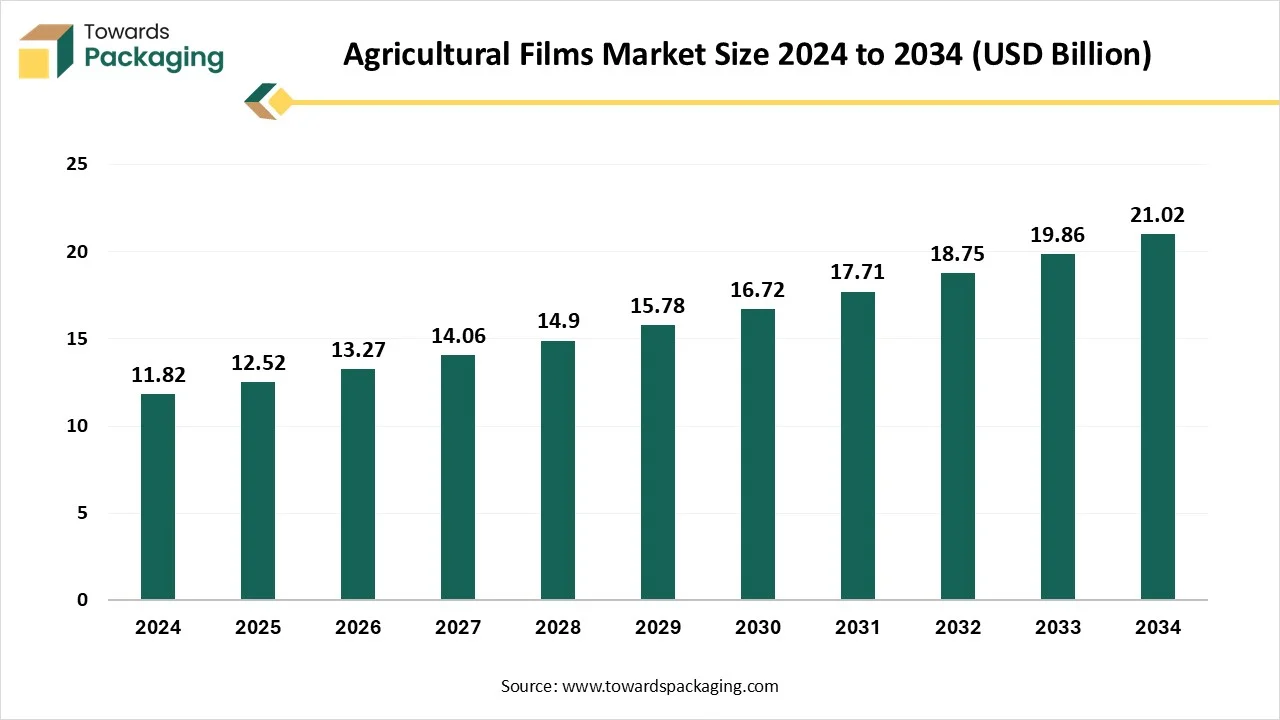
The agricultural films market is driven by the increasing demand for innovative and systematic agriculture methods to enhance crop quality by creating a controlled environment using the films inside the greenhouse. Mulch films are useful in maintaining soil temperature, preventing moisture loss, limiting weed growth, and improving crop yield. It is beneficial in large fruit and vegetable farms to control the quality of fruits and vegetables.
Another type is the tunnel films, which are used for protecting crops by creating a microclimate inside a mini tunnel. This helps protect the crop from adverse weather, pests, and diseases. Polyethylene and other Polymers are primarily used to produce agricultural films. The recent trend is the market shifting towards biodegradable materials due to sustainability practices. Increased awareness regarding environmental concerns is pushing the market towards the adoption of sustainable materials and solutions.
| Metric | Details |
| Market Size in 2024 | USD 11.82 Billion |
| Projected Market Size in 2034 | USD 21.02 Billion |
| CAGR (2025 - 2034) | 5.94% |
| Leading Region | Asia Pacific |
| Market Segmentation | By Material, By Type, By Application and By Region Covered |
| Top Key Players | RKW Group, Coveris, Rani Group, Groupe Barbier, Plastika Kritis, Industrial Development Company Sal |
AI is creating an impact on the agricultural films market in various ways. AI-driven intelligent systems are capable of regulating the greenhouse climate as per the requirements of the crop, they can handle other aspects such as pest control and disease detection in greenhouse agriculture. In the film production units, AI systems can provide valuable insights regarding the effective use of materials and the development effective agricultural films.
This helps to remove the defective units before they reach the market, so that there is no loss of product credibility. Inventory management, raw material orders scheduling, and effective utilization of available resources, these things are now taken care of by intelligent AI systems with utmost operational accuracy.
Rising Demand for Modern Agriculture Methods
Increasing food demand due to a rising global population is pushing the agricultural market to adopt innovative methods for increasing crop yield. One of the effective methods for increasing crop yield is greenhouse farming, where a greenhouse is created using films which has a controlled climate inside the greenhouse as per the crop requirement. it protects the crop against the extreme environmental conditions and maintains the crop quality. Mulch films are highly used to avoid soil erosion, stop the moisture escape, and prevent the growth of weeds. these are the factors that are driving the growth of the agricultural films market.
Challenges of Plastic Waste Management
The majority of agricultural films are manufactured using plastic materials. The government has announced regulations to curb plastic usage due to its harmful impact on the environment and water bodies. This is the major challenge currently faced by the agricultural films market. the market is looking for other innovative solutions, it is focusing on the recycling of the plastic material, use of biodegradable plastics. this approach of using biodegradable materials is one of the effective solutions currently available in the agricultural film market. these biodegradable products are gaining popularity due to their eco-friendliness and effectiveness as agricultural film material.
Use of Plant-Based Biodegradable Plastics Generating New Opportunities
The shifting trend of the market towards sustainable materials due to rising environmental concerns is driving the growth of sustainable materials in the agricultural films market. due to the Various government regulations and the harmful effects of plastic materials, their use is discouraged, and biodegradable materials are preferred. As they help to reduce the carbon footprint. Use of biodegradable material for mulch in farm lands discards the need to remove it as it naturally decomposes.
LLDPE dominated the market due to its high performance and cost-effectiveness. Its abundance in the market makes it easily accessible. The LLDPE's moisture barrier and UV resistance make it an effective material for agricultural films. Its ease of use makes it a popular choice for agricultural films. EVA is the fastest-growing material segment in the agricultural films market, it is due to its unique features like clarity, flexibility, and UV resistance, making it an ideal choice for greenhouses.
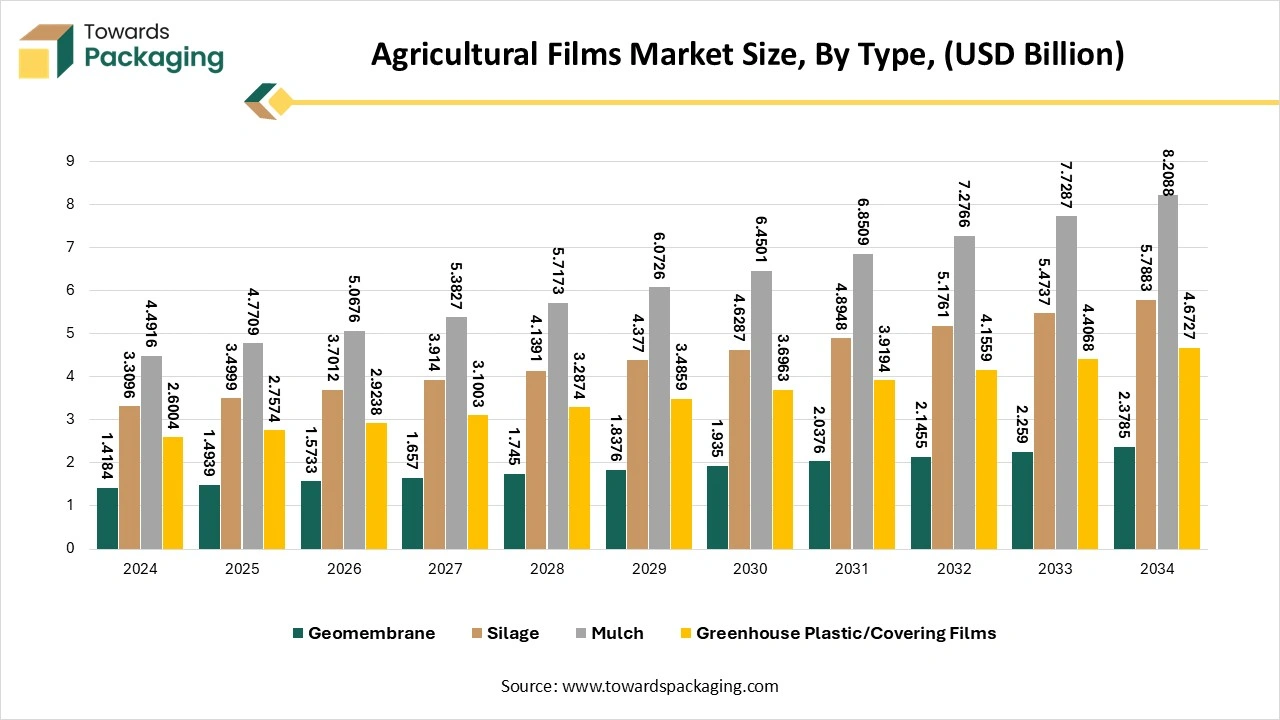
The mulching films dominated the type segment in the agricultural films market. the various applications of mulching films in agriculture are proving highly beneficial to improve crop yield, reduce water consumption, and reduce weeds in the farmland. Use of mulching films enhanced the utilisation of available resources without wasting them. Greenhouse plastic/covering films are expected to be the fastest growing segment in the agriculture film market. it is due to the rising emphasis on modern agriculture practices. in greenhouse the farming is done in a controlled environmental conditions. Controled moisture and humidity is ensured. Increasing focus on organic farming and advance technology is generating growth in this particular segment.
Bale wrapping & ensiling dominating the application segment in the agriculture films market due to its quality of application in the wrapping. It is highly used in wrapping the round bales of foder. Which are used for creating airtight barriers for preservation of silage. Silo Bag Manufacturing is the fastest growing application segment in the agricultural film market due to its increasing demand for food storage such as grains due to its high efficiency and durability.
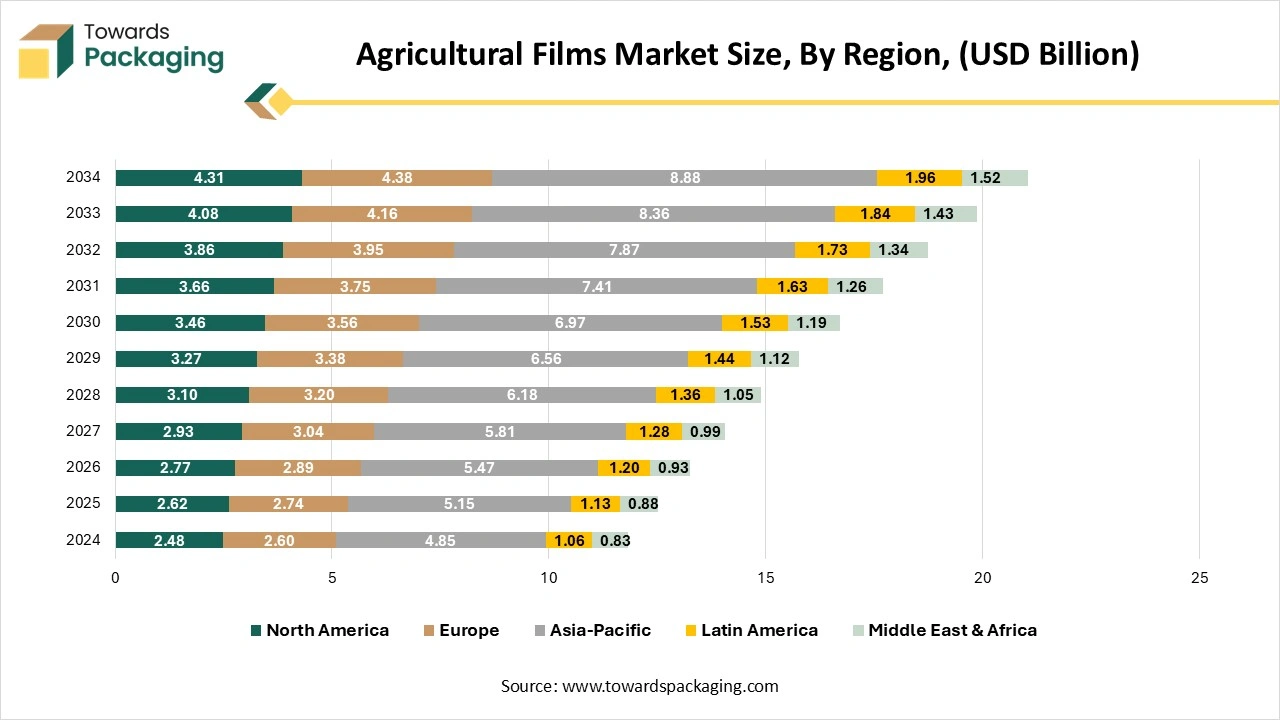
Being situated with a country like India where majority of its land around 50% is under the agriculture, has a huge requirement for agriculture films for various applications. this region is also has a huge population and huge food requirement in countries like China and India. which creates the necessity to find various innovative ways to produce high quality crop in high amount with natural ways. as the pesticides and chemical fertilizers are damaging the land which is gradually reducing the ability to produce good quality food as the time passing. this requirement is shifting the agriculture market towards the greenhouse farming and other innovative solutions to increase the crop quality and quantity while maintaining the health of soil.
North American market is expected to be the fastest growing region in the agricultural film market, due to its rising emphasize on modern agriculture practices. in this region the shifted trend and increased demand for organic food is driving the growth of greenhouse farming. which is making it one of the fastest growing regions in agriculture film market. technological advancements and various technology infusion such as AI and IoT in the agriculture has completely changed the agriculture methods in the North American region. which is driving growth and expected to continue the fastest growth in this region for agriculture film market.
Notable growth is observed in the European region for agriculture film market due to increasing modern agriculture and greenhouse farming for producing various types of crops under controlled environment. with the help of technology and AI. The health-conscious consumer base is creating huge demand for organic food instead of produced using pesticides and chemical fertilizers. organic farming is booming in this region which is creating a huge opportunity for the greenhouse farming and use of natural methods to produce high quality crop yield.
The agricultural films and bonding market is experiencing remarkable growth, with revenue expected to soar into the hundreds of millions from 2025 to 2034. This expansion is fueled by the increasing demand for sustainable farming solutions and innovative materials that enhance crop protection, soil health, and yield efficiency.
The rising demand for sustainable agricultural solutions in various regions has enhanced this market's demand worldwide. Farmers are adapting new methods to yield more crops, protect crops from pests, and conserve water while irrigation increases demand for agricultural films and bonding markets.
The agricultural films and bonding market is rising rapidly due to the growing demand for sustainable farming choices, technological advancement, UV rays protection, temperature control, and crop protection. These types of films are mainly used in mulch films, irrigation systems, greenhouse covers, and silage films to improve crop yielding and protect from the adverse effects of the environment. These films are clear, transparent, durable, diffusion, and degradation properties are ideal for agricultural purposes.
These inventions play a significant role in enhancing crop yields by allowing better regulation over development conditions, pest management, and soil health, vital for meeting the rising food demands of an escalating worldwide population. Technological improvements are generating prospects for the expansion of advanced agricultural films and bonding resolutions. Films with light transmission, enhanced durability, and eco-friendliness are developing. Bonding solutions that deliver improved weather resistance and joint strength are also fast traction.
The polyethylene films market is expected to grow from USD 100.73 billion in 2025 to USD 149.69 billion by 2034, with a CAGR of 4.5% throughout the forecast period from 2025 to 2034.
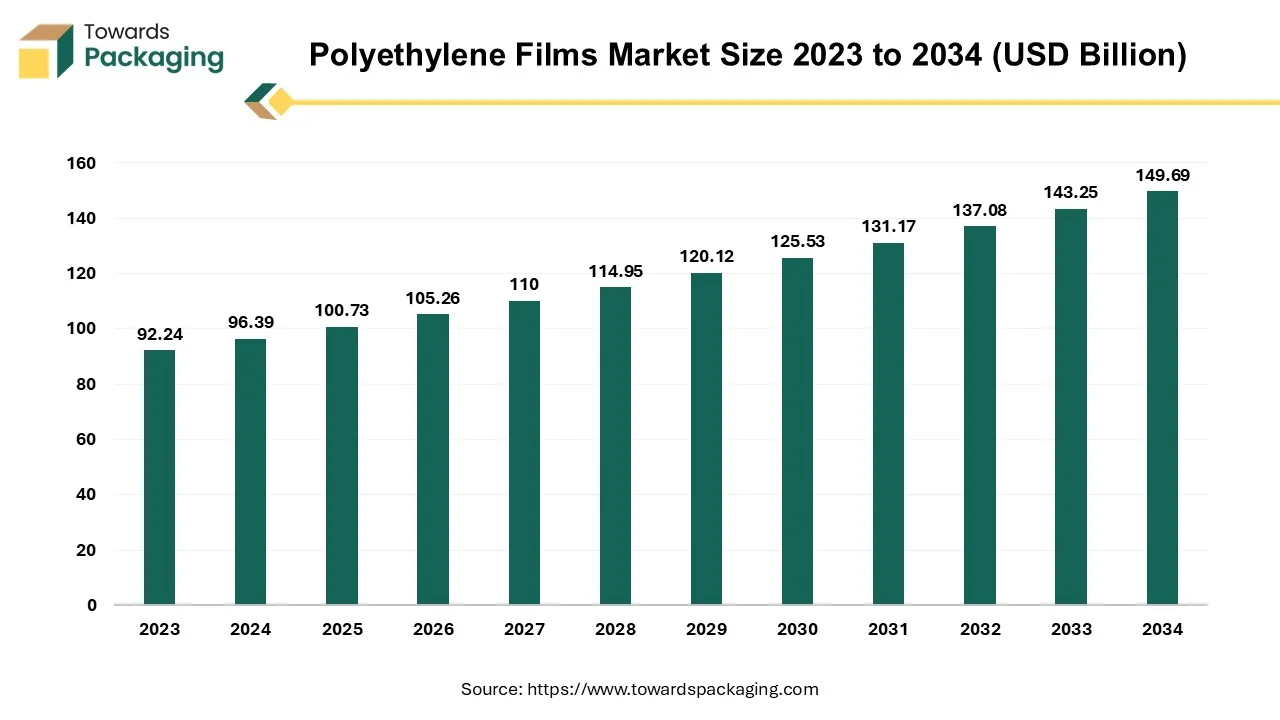
The chemical ethylene, which is present in natural gas and petroleum, is the source of the polymer film that is called polyethylene (PE). considering its many uses, PE film is referred to by many different kinds of names, including plastic sheeting, polyethylene sheet, poly sheeting, and poly film. Despite over 100 million metric tonnes of PE resin generated annually, polyethylene has become the plastic material that is used the most globally. PE makes up nearly 34% of all polymer produced globally. The production of polyethylene is expected to be 22.67 million metric tonnes. An extensive selection of packaging materials, such as bags, wraps, pouches, and sacks, are able to be manufactured by moulding polyethylene films.
The polypropylene packaging films market is expected to increase from USD 30.75 billion in 2025 to USD 52.13 billion by 2034, growing at a CAGR of 6.04% throughout the forecast period from 2025 to 2034.
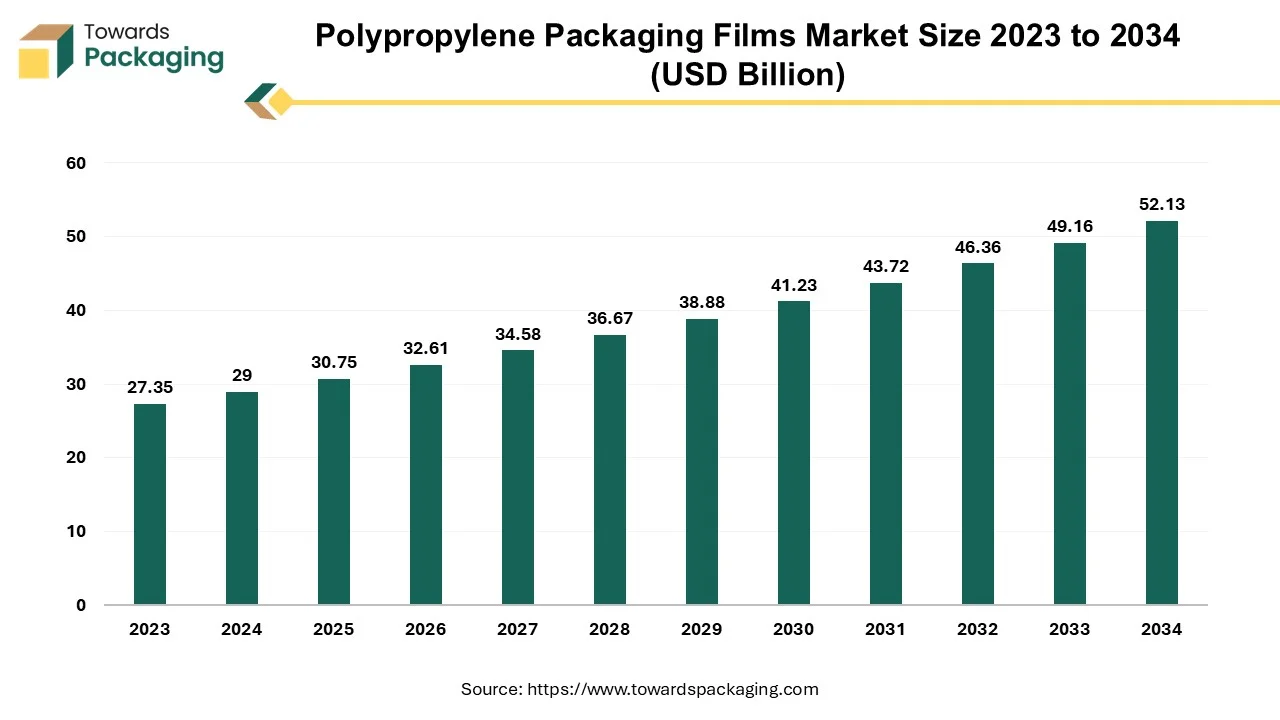
The polypropylene packaging films market is anticipated to witness significant growth during the forecast period. Polypropylene (PP) film serves as a thermoplastic that is both inexpensive and fully recyclable. These films are appropriate for applications requiring sterilization at extreme temperatures since they have good tensile strength, high gloss, high clarity and relatively high melting point. Polypropylene is best suited for use in the food and beverage and packaging industries owing to its special qualities. Due to its excellent chemical resistance, low odor and inertness, polypropylene film is the preferred material for packaging applications which must adhere to the FDA requirements. Polypropylene film is commonly used for tape liners, food wraps, cigarette packing, shrink wrap, candy packaging, diapers and sterile wrap.
The green packaging film market is set to grow from USD 12.96 billion in 2025 to USD 21.77 billion by 2034, with an expected CAGR of 5.93% over the forecast period from 2025 to 2034.
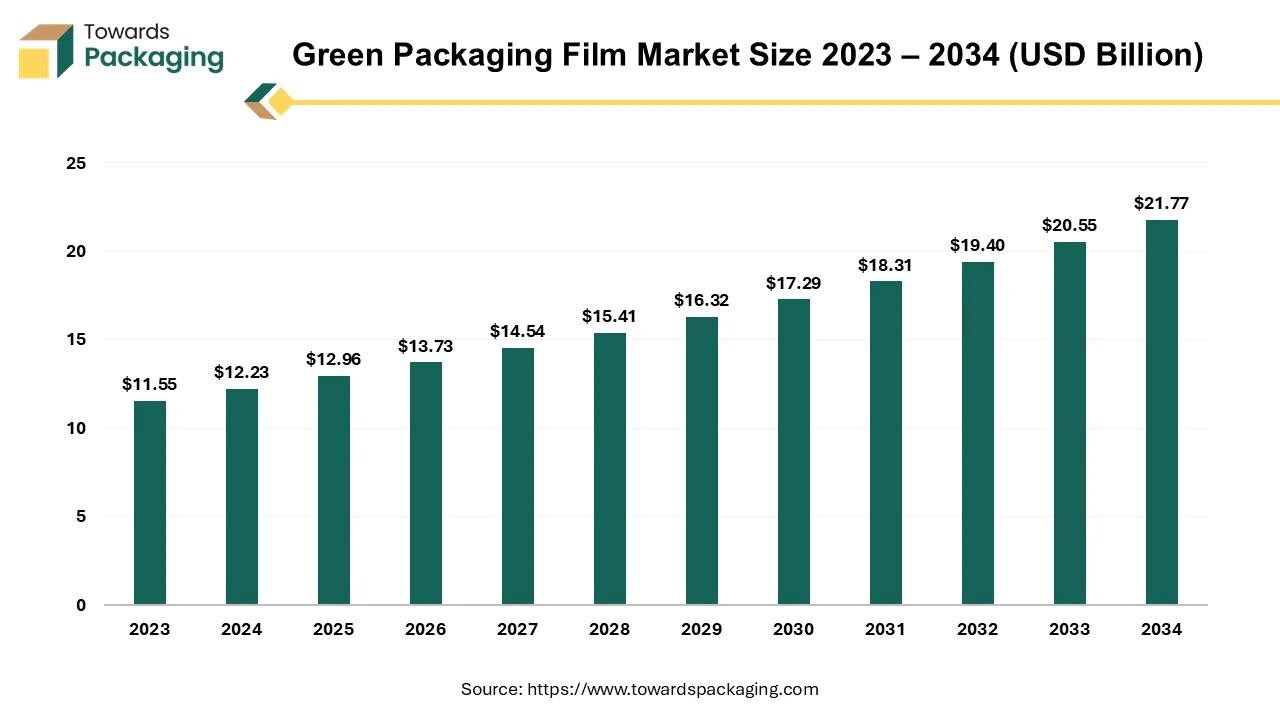
The term "green packaging" describes the creation and application of sustainable and ecologically friendly packaging. Compostable, biodegradable, or recyclable materials are used in green packaging. This involves using materials that are easily repurposed or decomposable without leaving behind hazardous residues, as well as recycled content. Reduction The goal is to use less packaging material overall. This is creating packages that are more compact or effective in order to reduce waste and preserve resources. Rather than using petroleum-based plastics, green packaging frequently uses materials made from renewable resources, such as plant-based materials (like bamboo, hemp, or cornstarch). Reducing greenhouse gas emissions and energy consumption are the two main goals of the green packaging production process.
The plastic films and sheets market is expected to increase from USD 154.59 billion in 2025 to USD 253.52 billion by 2034, growing at a CAGR of 5.65% throughout the forecast period from 2025 to 2034.
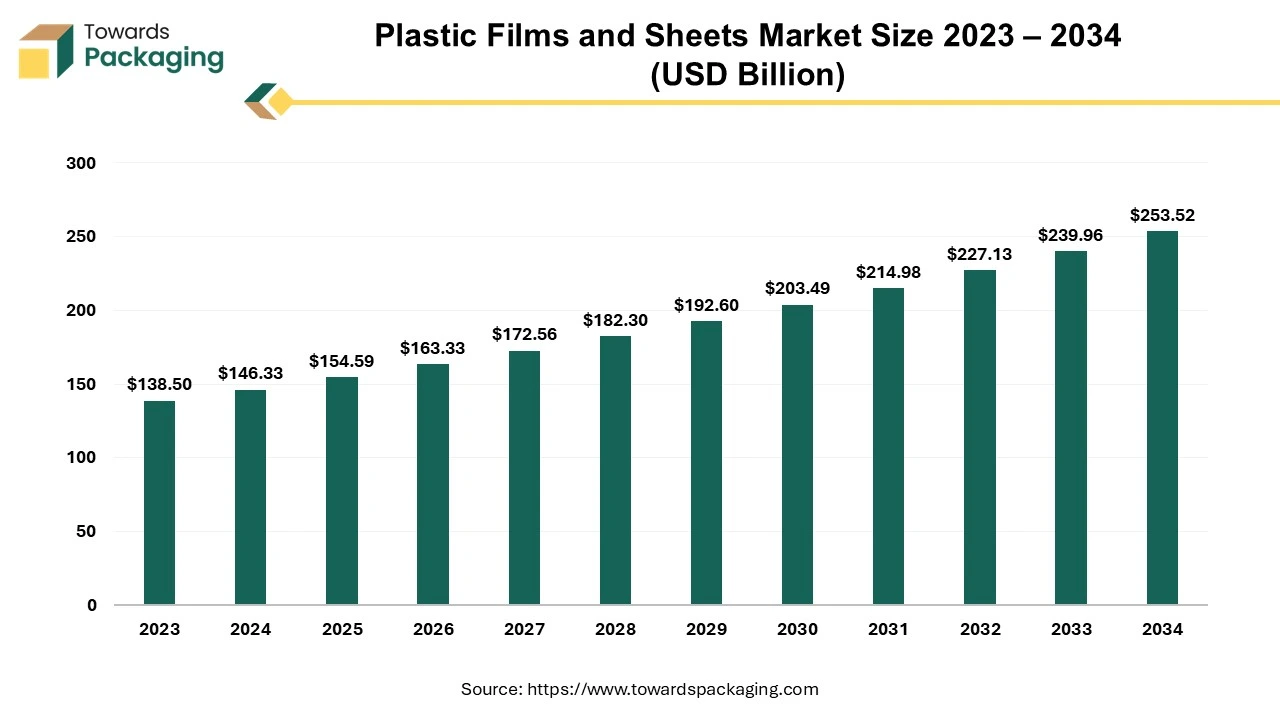
The key players operating in the market are focused on adopting inorganic growth strategies like acquisition and merger to develop advance technology for manufacturing plastic films and sheets which is estimated to drive the global plastic films and sheets market over the forecast period. Plastic films and sheets are thin, flexible materials manufactured from various types of plastic polymers, often utilized in an extensive range of industries for packaging, protection, insulation, and styling decorative purposes. These materials are typically characterized by their thinness (films being thinner than sheets) and are produced by extruding plastic into continuous, uniform rolls or flat pieces.

By Material
By Type
By Application
By Region Covered
December 2025
December 2025
November 2025
November 2025